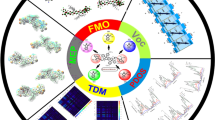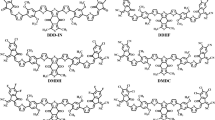Abstract
Recently, non-fullerenes acceptor based solar cells have replaced the fullerenes based ones due to their higher enhanced photochemical and thermal stability. Hence, in this work, six molecules based on D–A and D–A–D topologies have been designed, where dipyridophenazine as acceptor (which is attached with a metal atom) is attached with triphenylamine as the donor fragment. In case of D–A topology based A1–A3 molecules, donor: acceptor ratio is 1:1 while in D–A–D type B1–B3 molecules it is 1:2. Computational analyses based on density functional and time-dependent density functional are carried out to investigate the effect of Ca, Mg, and Be metals in both topologies. Reduced orbital energy levels in all designed molecules refer to them as good acceptors in both topologies. Ca-complexed (A1 and B1) acceptors in both topologies after the optimal function have shown a smaller energy gap of 0.6 eV than those of reference R and all other designed molecules. In case of D–A–D topology, B1 showed a significant red-shift of 72 nm than that of R. While D–A topology-based A1 showed a more or less similar absorption wavelength like R. Besides, absorption peaks of Mg and Be-complexed molecules are stronger in the case of D–A–D topology. In a nutshell, this computational investigation approved these molecules as efficient and effective for non-fullerene organometallic based acceptors for organic solar cell devices.






Similar content being viewed by others
References
J. Baldenebro-López et al., Computational molecular nanoscience study of the properties of copper complexes for dye-sensitized solar cells. Int. J. Mol. Sci. 13(12), 16005–16019 (2012)
H.B. Khalil, S.J.H. Zaidi, Energy crisis and potential of solar energy in Pakistan. Renew. Sustain. Energy Rev. 31, 194–201 (2014)
N. Panwar, S. Kaushik, S. Kothari, Role of renewable energy sources in environmental protection: a review. Renew. Sustain. Energy Rev. 15(3), 1513–1524 (2011)
E.H. Lysen, F. van Hulle, Pumping water with solar cells. Int. Energy J. 4(1), 54 (2017)
A.J. Nozik, J. Miller, Introduction to Solar Photon Conversion (ACS Publications, Washington, 2010).
N.S. Lewis, Toward cost-effective solar energy use. Science 315(5813), 798–801 (2007)
S. Binetti et al., Key success factors and future perspective of silicon-based solar cells. Int. J. Photoenergy (2013). https://doi.org/10.1155/2013/249502
P.-L. Ong, I. Levitsky, Organic/IV, III-V semiconductor hybrid solar cells. Energies 3(3), 313–334 (2010)
C.A. Wolden et al., Photovoltaic manufacturing: present status, future prospects, and research needs. J. Vacuum Sci. Technol. A 29(3), 030801 (2011)
M.A. Green et al., Solar cell efficiency tables (version 50). Prog. Photovoltaics Res. Appl. 25(7), 668–676 (2017)
S. Bibi, J. Zhang, The ratio and topology effects of benzodithiophene donor–benzooxadiazole acceptor fragments on the optoelectronic properties of donor molecules toward solar cell materials. Phys. Chem. Chemical Physics 17(12), 7986–7999 (2015)
M.D. Irwin et al., Structural and electrical functionality of NiO interfacial films in bulk heterojunction organic solar cells. Chem. Mater. 23(8), 2218–2226 (2011)
G. Sathiyan et al., Review of carbazole based conjugated molecules for highly efficient organic solar cell application. Tetrahedron Lett. 57(3), 243–252 (2016)
G. Niu, X. Guo, L. Wang, Review of recent progress in chemical stability of perovskite solar cells. J. Mater. Chem. A 3(17), 8970–8980 (2015)
A. Mishra, P. Bäuerle, Small molecule organic semiconductors on the move: promises for future solar energy technology. Angew. Chem. Int. Ed. 51(9), 2020–2067 (2012)
L. Fan et al., A new small molecule with indolone chromophore as the electron accepting unit for efficient organic solar cells. Dyes Pigm. 113, 458–464 (2015)
K. Do et al., New DADAD push–pull organic semiconductors with different benzo [1, 2-b: 4, 5-b′] dithiophene cores for solution processed bulk heterojunction solar cells. Dyes Pigm. 120, 126–135 (2015)
H. Zhou, L. Yang, W. You, Rational design of high performance conjugated polymers for organic solar cells. Macromolecules 45(2), 607–632 (2012)
P. Morvillo, E. Bobeico, Tuning the LUMO level of the acceptor to increase the open-circuit voltage of polymer-fullerene solar cells: a quantum chemical study. Sol. Energy Mater. Sol. Cells 92(10), 1192–1198 (2008)
J. Zhang et al., Conjugated polymer–small molecule alloy leads to high efficient ternary organic solar cells. J. Am. Chem. Soc. 137(25), 8176–8183 (2015)
J.J. Bergkamp, S. Decurtins, S.-X. Liu, Current advances in fused tetrathiafulvalene donor–acceptor systems. Chem. Soc. Rev. 44(4), 863–874 (2015)
C.-Z. Li, H.-L. Yip, A.K.-Y. Jen, Functional fullerenes for organic photovoltaics. J. Mater. Chem. 22(10), 4161–4177 (2012)
J. Hou et al., Organic solar cells based on non-fullerene acceptors. Nat. Mater. 17(2), 119 (2018)
X. Zhang, J. Yao, C. Zhan, A selenophenyl bridged perylenediimide dimer as an efficient solution-processable small molecule acceptor. Chem. Commun. 51(6), 1058–1061 (2015)
Z. Liu et al., Non-fullerene small molecule acceptors based on perylenediimides. J. Mater. Chem. A 4(45), 17604–17622 (2016)
W.S. Shin et al., Effects of functional groups at perylenediimide derivatives on organic photovoltaic device application. J. Mater. Chem. 16(4), 384–390 (2006)
U. Saeed et al., Designation and match of non-fullerene acceptors with X-shaped donors toward organic solar cells. ChemistrySelect 4(13), 3654–3664 (2019)
H. Hoppe, N.S. Sariciftci, Organic solar cells: an overview. J. Mater. Res. 19(7), 1924–1945 (2004)
X. Guégano et al., Pronounced electrochemical amphotericity of a fused donor-acceptor compound: a planar merge of TTF with a TCNQ-Type bithienoquinoxaline. Chem. A Eur. J. 15(1), 63–66 (2009)
S. Bibi et al., Effect of different topological structures (D-π-D and D-π-A-π-D) on the optoelectronic properties of benzo [2, 1-B: 3, 4-B́] dithiophene based donor molecules toward organic solar cells. Sol. Energy 186, 311–322 (2019)
A.R. Belverdi et al., Novel donor-acceptor non-fullerene metal-organic solar cells: a first DFT and TD-DFT study. Phys. B 542, 37–43 (2018)
S. Bibi, P. Li, J. Zhang, X-Shaped donor molecules based on benzo [2, 1-b: 3, 4-b′] dithiophene as organic solar cell materials with PDIs as acceptors. J. Mater. Chem. A 1(44), 13828–13841 (2013)
T. Shigehiro et al., Novel 10, 13-disubstituted dipyrido [3, 2-a: 2′, 3′-c] phenazines and their platinum (II) complexes: highly luminescent ICT-type fluorophores based on D-A–D structures. Tetrahedron Lett. 55(37), 5195–5198 (2014)
B. Du, D. Fortin, P.D. Harvey, A conjugated organometallic polymer with truxene antennas as side arms; a multiluminescent material with evidence for intrachain MO couplings. J. Inorg. Organomet. Polym Mater. 23(1), 81–88 (2013)
J. Preat, Photoinduced energy-transfer and electron-transfer processes in dye-sensitized solar cells: TDDFT insights for triphenylamine dyes. J. Phys. Chem. C 114(39), 16716–16725 (2010)
S. Mohakud, S.K. Pati, Large carrier mobilities in octathio [8] circulene crystals: a theoretical study. J. Mater. Chem. 19(25), 4356–4361 (2009)
D. Song et al., Determination of pKa and the corresponding structures of quinclorac using combined experimental and theoretical approaches. J. Mol. Struct. 1152, 53–60 (2018)
A. Saeed et al., Exploring the impact of central core modifications among several push-pull configurations to enhance nonlinear optical response. J. Mol. Graph. Model. 100, 107665 (2020)
M. Noormohammadbeigi et al., Feasibility of Ca12O12Nanocluster in Lithium and Sodium Atom/Ion Batteries: DFT Study. J. Inorg. Organometall. Polym. Mater. (2020). https://doi.org/10.1007/s10904-020-01788-z
Z. Zara et al., Designing benzodithiophene-based donor materials with favorable photovoltaic parameters for bulk heterojunction organic solar cells. ChemistrySelect 2(20), 5628–5639 (2017)
S. Bibi, J. Zhang, Theoretical studies to investigate the effect of different cores and two different topologies on the optical and charge transfer properties of donor materials for organic solar cells. New J. Chem. 40(4), 3693–3704 (2016)
N. Noorussabah et al., Copper(II) and nickel(II) complexes of tridentate hydrazide and schiff base ligands containing phenyl and naphthalyl groups: synthesis, structural, molecular docking and density functional study. J. Inorg. Organomet. Polym Mater. 30(11), 4426–4440 (2020)
M.C. Scharber et al., Design rules for donors in bulk-heterojunction solar cells—towards 10% energy-conversion efficiency. Adv. Mater. 18(6), 789–794 (2006)
A. El Assyry et al., Optical and photovoltaic properties of new quinoxalin-2 (1H)-one-based DA organic dyes for efficient dye-sensitized solar cell using DFT. J. Mater. Environ. Sci. 6(9), 2612–2623 (2015)
S. UrRehman et al., The effect of different aromatic conjugated bridges on optoelectronic properties of diketopyrrolopyrrole-based donor materials for organic photovoltaics. J. Mol. Model. 26(6), 154–154 (2020)
S. AlFaify et al., Quantum chemical investigation on molecular structure, vibrational, photophysical and nonlinear optical properties of l-threoninium picrate: an admirable contender for nonlinear applications. J. Comput. Electron. 17(4), 1421–1433 (2018)
A. Waqas et al., Substitutional effect of different bridging groups on optical and charge transfer properties of small bipolar molecules for OLEDs. J. Phys. Org. Chem. 32(11), e4000 (2019)
L. Hao et al., Theoretical studies of heteroatom-doping in TiO 2 to enhance the electron injection in dye-sensitized solar cells. RSC Adv. 5(97), 79868–79873 (2015)
M. Adnan et al., Fine tuning the optoelectronic properties of triphenylamine based donor molecules for organic solar cells. Zeitschrift für Phys. Chem. 231(6), 1127–1139 (2017)
M. Shoaib et al., Theoretical Investigation Of PeryleneDiimide Derivatives As Acceptors To Match With Benzodithiophene Based Donors For Organic Photovoltaic Devices. Zeitschrift für Phys. Chem. (2019). https://doi.org/10.1515/zpch-2019-1451
W. Zhao et al., Molecular optimization enables over 13% efficiency in organic solar cells. J. Am. Chem. Soc. 139(21), 7148–7151 (2017)
M. Bourass et al., DFT/TD-DFT characterization of conjugational electronic structures and spectral properties of materials based on thieno [3, 2-b][1] benzothiophene for organic photovoltaic and solar cell applications. J. Saudi Chem. Soc. 21(5), 563–574 (2017)
R.G. Pearson, Absolute electronegativity and hardness correlated with molecular orbital theory. Proc. Natl. Acad. Sci. 83(22), 8440–8441 (1986)
M. Essid et al., Synthesis, characterization, Hirshfeld surface analysis and computational studies of 1-methylpiperazine-1, 4-diium bis (hydrogen oxalate):[C5H14N2](HC2O4)2. J. Mol. Struct. 1211, 128075 (2020)
H. Abbas, M. Shkir, S. AlFaify, Density functional study of spectroscopy, electronic structure, linear and nonlinear optical properties of l-proline lithium chloride and l-proline lithium bromide monohydrate: For laser applications. Arab. J. Chem. 12(8), 2336–2346 (2019)
S. Muhammad et al., Benchmark study of the linear and nonlinear optical polarizabilities in proto-type NLO molecule of para-nitroaniline. J. Theor. Comput. Chem. 18(06), 1950030 (2019)
Acknowledgements
The calculations were performed in the computational chemistry laboratory at the department of chemistry, University of Agriculture Faisalabad, Pakistan. The authors highly acknowledge the Higher education commission (HEC (Grant # 21-1083/SRGP)) of Pakistan for financial and the University of Agriculture Faisalabad for technical support.
Author information
Authors and Affiliations
Corresponding author
Additional information
Publisher's Note
Springer Nature remains neutral with regard to jurisdictional claims in published maps and institutional affiliations.
Supplementary Information
Below is the link to the electronic supplementary material.
Rights and permissions
About this article
Cite this article
Shafiq-ur-Rehman, Ghafoor, S., BiBi, S. et al. DFT and TDDFT Studies of Non-Fullerene Organometallic Based Acceptors for Organic Photovoltaics. J Inorg Organomet Polym 31, 1676–1687 (2021). https://doi.org/10.1007/s10904-020-01833-x
Received:
Accepted:
Published:
Issue Date:
DOI: https://doi.org/10.1007/s10904-020-01833-x




